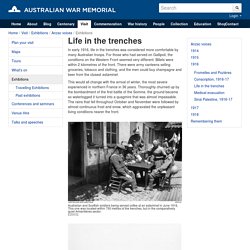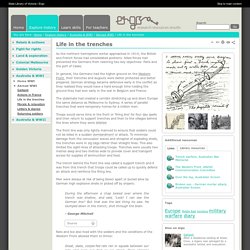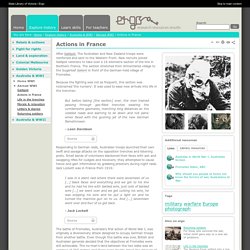

The Anzac Portal. Battles of the Western Front 1914-1918. World War One - The Western Front. The opening engagement on the Western Front was the Battle of Mons on 23rd August 1914.

However after early battles of movement, the Western Front stagnated into trench warfare. In 1915, efforts were made to break the deadlock with costly Allied offenses at Neuve Chapelle and later in September at the Battle of Loos. However the German defensive system, protected by machine guns and barbed wire, was too strong. Around Ypres (pronounced ‘Wipers’ by British soldiers) the water table was too high to dig trenches. Instead, defences were constructed using sandbags and wood (called ‘breastworks’) and were heavily protected by barbed wire, the defining feature of the Western Front. Animals played an important role on the Western Front in World War One. On the Western Front, the birds were kept in mobile pigeon lofts.
These brave birds not only had to contend with enemy fire but also with trained hawks which were employed to bring down the pigeons. Tank Corps Officers, 1918 >> More World War One. Imperial War Museums. How did soldiers cope with war? Curator Dr Matthew Shaw, explores notions of patriotism, social cohesion, routine and propaganda, to ask how soldiers of World War One were able to psychologically cope with the realities of combat.

Introduction Given our understanding of the horrors of war, it is often difficult to understand how men coped with life at the Front during the First World War. Many, of course, did not: it is during this period that shell shock and what we now know as post-traumatic stress disorder were first described and diagnosed . BBC Schools - Life in the trenches. 31 October 2014Last updated at 15:07 Two British soldiers standing in a flooded communication trench during World War One On the Western Front, the war was fought in trenches. Trenches were long, narrow ditches dug into the ground where soldiers lived all day and night. There were many lines of German trenches on one side and many lines of Allied trenches on the other. In the middle, was no man's land, so-called because it did not belong to either army.
Rest. WWI: Life on the western front. US Army, Signal Corps. 1918.

"115th Regiment Field Artillery of the Thirtieth Division passing a group of German prisoners under guard of 9th Infantry, Laronville, France, September 12, 1918" State Archives of North Carolina.American soldiers of World War I experienced a great deal of hardship while fighting on the western front in France and Belgium. Since air transportation was still a dream, America’s doughboys traveled on ships to France. These troop ships were often crowded and uncomfortable, with bunks stacked several layers high, and the men and their equipment forced into tiny spaces. The soldiers came up on deck only once or twice a day, usually for exercise or lifeboat drill. Many had never been to sea before, so they became sick from the pitching and rolling of the ship.
Troop ships sailed in convoys, groups of twenty-five or thirty vessels sailing in formation. Almost all Americans arrived at French ports like Saint-Nazaire and Brest. Life in the trenches. In early 1916, life in the trenches was considered more comfortable by many Australian troops.

For those who had served on Gallipoli, the conditions on the Western Front seemed very different. Billets were within 2 kilometres of the front. There were army canteens selling groceries, tobacco and clothing, and the men could buy champagne and beer from the closest estaminet. This would all change with the arrival of winter, the most severe experienced in northern France in 36 years. Life in the trenches. As the northern hemisphere winter approached in 1914, the British and French forces had consolidated positions.

Allied forces had prevented the Germans from reaching two key objectives: Paris and the port of Calais. In general, the Germans had the higher ground on the Western Front, their trenches and dugouts were better protected and better prepared. German strategy became defensive early in the conflict as they realised they would have a hard enough time holding the ground they had won early in the war in Belgium and France. The stalemate had created a corridor stretching up and down Europe the same distance as Melbourne to Sydney. Troops would serve time in the front or ‘firing line’ for four day spells and then return to support trenches and then to the villages behind the lines where they were billeted The front line was only lightly manned to ensure that soldiers could not be killed in a sudden bombardment or attack. Actions in France.
After Gallipoli, The Australian and New Zealand troops were reinforced and sent to the Western Front.

New recruits joined Gallipoli veterans to take over a 16 kilometre section of the line in Northern France.